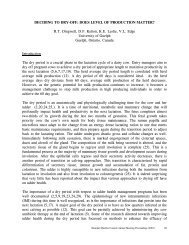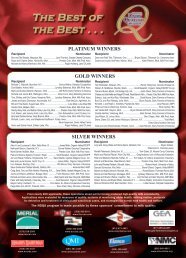Milking System Cleaning and Sanitizing - National Mastitis Council
Milking System Cleaning and Sanitizing - National Mastitis Council
Milking System Cleaning and Sanitizing - National Mastitis Council
Create successful ePaper yourself
Turn your PDF publications into a flip-book with our unique Google optimized e-Paper software.
<strong>Cleaning</strong> Problems And Bacteria Count Issues<br />
The result of ineffective cleaning often is bacteria count problems. A typical well-cleaned <strong>and</strong><br />
sanitized system should be able to produce milk with less than 10,000 bacteria/ml. When the count<br />
is greater cleanliness of the system needs to be inspected.<br />
Soiled <strong>and</strong> dirty milking systems provide food <strong>and</strong> shelter for bacteria. The milk films protect the<br />
bacteria from cleaning <strong>and</strong> sanitizing solutions allowing them to build in numbers. It may not<br />
happen immediately but in time the number of bacteria present will increase if system cleaning is<br />
not effective.<br />
A major increase in the st<strong>and</strong>ard plate count may be first indication of problems simply because<br />
that is the most commonly used test. It measures bacteria that grow in warm conditions in a 48hour<br />
period. If a system is dirty it will allow more bacteria to grow <strong>and</strong> end up in the bulk milk.<br />
This means the starting number of bacteria for the SPC test is increased so the final count will be<br />
higher as well.<br />
The PI count is another measure of bacteria in raw milk <strong>and</strong> is an attempt to identify the presence<br />
of bacteria that may grow preferentially in cold milk.<br />
Another test sometimes used for evaluating milking system cleanliness is the Lab Pasteurized<br />
Count or LPC. It only measures bacteria that survive pasteurization conditions. This excludes<br />
mastitis causing bacteria <strong>and</strong> most of the normal soil organisms. There are certain soil bacteria<br />
however that can survive in the system <strong>and</strong> cause problems later on. These are frequently<br />
associated with a dirty system.<br />
Finally don’t forget the bulk tank. It represents a very large surface area that can be difficult to<br />
clean. Typically the cleaning system for tanks involves a spray ball(s), which distributes rinse water<br />
<strong>and</strong> cleaning solutions to all areas of the interior surface when working properly. The same basic<br />
program <strong>and</strong> chemicals are used as are used to clean <strong>and</strong> sanitize the pipeline <strong>and</strong> milking<br />
equipment.<br />
Typical problems include failure of the spray ball system. They may become partially plugged <strong>and</strong><br />
fail to apply cleaners to all interior surfaces. Mixing paddles may not be well cleaned <strong>and</strong> outlet<br />
valves can occasionally be a problem. Lack of hot water, failure to provide adequate strength<br />
cleaning solutions can be issues. Mineral buildup in certain areas can be an issue that can lead to<br />
surface films such as protein films <strong>and</strong> these can hold milk soils <strong>and</strong> promote bacterial growth.<br />
All system-cleaning programs rely heavily on time, temperature, chemicals at the proper<br />
concentration <strong>and</strong> physical cleaning action. Problems usually can be traced back to deficiencies in<br />
one or more of these areas. Taking time routinely to make certain these are acceptable is the best<br />
way to eliminate cleaning issues that may contribute to bacteria problems in raw milk.<br />
60 <strong>National</strong> <strong>Mastitis</strong> <strong>Council</strong> Regional Meeting Proceedings (2002)





